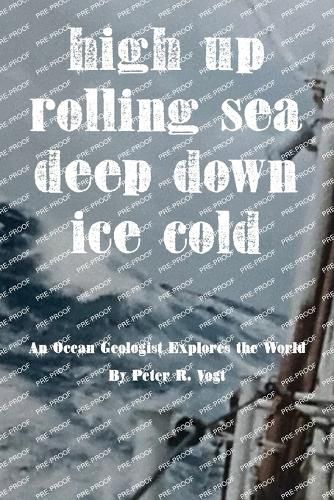Readings Newsletter
Become a Readings Member to make your shopping experience even easier.
Sign in or sign up for free!
You’re not far away from qualifying for FREE standard shipping within Australia
You’ve qualified for FREE standard shipping within Australia
The cart is loading…






Armchair readers of High Up, Rolling Sea, Deep Down, Ice Cold will imagine themselves intimate explorers of Earth's most remote and forbidding places. You'll travel in the company of Peter Vogt, an intrepid driven by his own nature to seek out extreme climates and locales. Vogt chased ice and climbed mountains and volcanoes on three continents before devoting himself to Earth's final frontier: the depths of the 71 percent of our planet that is ocean.
Following an unerring instinct for opportunity, he trained at the University of Innsbruck (Austria), Cal Tech and the University of Wisconsin, balancing physical science at its finest with the icy chill that always felt like home to him. As a student and ocean geologist, primarily for the Naval Research Laboratory, he voyaged from the Antarctic to the Arctic, transversing all of Earth's six oceans, seven continents, thirty-one subcontinents and far-flung islands.
The voyages you'll share with Vogt are far from the high luxury of 21st century ocean liners. With one exception, his teaching cruise along the equator on the Cunard Adventurer to see the June 30, 1973, total eclipse of the sun, he traveled rough on working ships fitted for exploration, enduring sea sickness, bad food and ribald equatorial initiations. Ships ranged from the 400-foot-Glomar Challenger to the tiny 25.5-foot-long Mir submersibles.
Most traveled the high seas, with the Glomar Challenger lowering four miles of pipe core into seafloor sediments. Mir descended three miles to the floor of the Molloy Deep, the Arctic Ocean's deepest spot. In the 145-foot US submarine NR-1, Vogt was part of a crew motoring along the ocean floor at 3,000 feet deep.
When ships couldn't do the job, Vogt switched to airplanes, zig-zagging over the Southern Hemisphere's night skies in the specially outfitted The Lockheed Constellation Paisano Dos (Lockheed NC-121K) to make land gravity measurements and monitor the reception of satellite navigation signals.
Over four decades, he traveled 10 tomes around Earth at the equator to see our planet and show it to us in this book and historic global map, The Dynamic Planet.
See you aboard High Up, Rolling Sea, Deep Down, Ice Cold.
$9.00 standard shipping within Australia
FREE standard shipping within Australia for orders over $100.00
Express & International shipping calculated at checkout
Armchair readers of High Up, Rolling Sea, Deep Down, Ice Cold will imagine themselves intimate explorers of Earth's most remote and forbidding places. You'll travel in the company of Peter Vogt, an intrepid driven by his own nature to seek out extreme climates and locales. Vogt chased ice and climbed mountains and volcanoes on three continents before devoting himself to Earth's final frontier: the depths of the 71 percent of our planet that is ocean.
Following an unerring instinct for opportunity, he trained at the University of Innsbruck (Austria), Cal Tech and the University of Wisconsin, balancing physical science at its finest with the icy chill that always felt like home to him. As a student and ocean geologist, primarily for the Naval Research Laboratory, he voyaged from the Antarctic to the Arctic, transversing all of Earth's six oceans, seven continents, thirty-one subcontinents and far-flung islands.
The voyages you'll share with Vogt are far from the high luxury of 21st century ocean liners. With one exception, his teaching cruise along the equator on the Cunard Adventurer to see the June 30, 1973, total eclipse of the sun, he traveled rough on working ships fitted for exploration, enduring sea sickness, bad food and ribald equatorial initiations. Ships ranged from the 400-foot-Glomar Challenger to the tiny 25.5-foot-long Mir submersibles.
Most traveled the high seas, with the Glomar Challenger lowering four miles of pipe core into seafloor sediments. Mir descended three miles to the floor of the Molloy Deep, the Arctic Ocean's deepest spot. In the 145-foot US submarine NR-1, Vogt was part of a crew motoring along the ocean floor at 3,000 feet deep.
When ships couldn't do the job, Vogt switched to airplanes, zig-zagging over the Southern Hemisphere's night skies in the specially outfitted The Lockheed Constellation Paisano Dos (Lockheed NC-121K) to make land gravity measurements and monitor the reception of satellite navigation signals.
Over four decades, he traveled 10 tomes around Earth at the equator to see our planet and show it to us in this book and historic global map, The Dynamic Planet.
See you aboard High Up, Rolling Sea, Deep Down, Ice Cold.